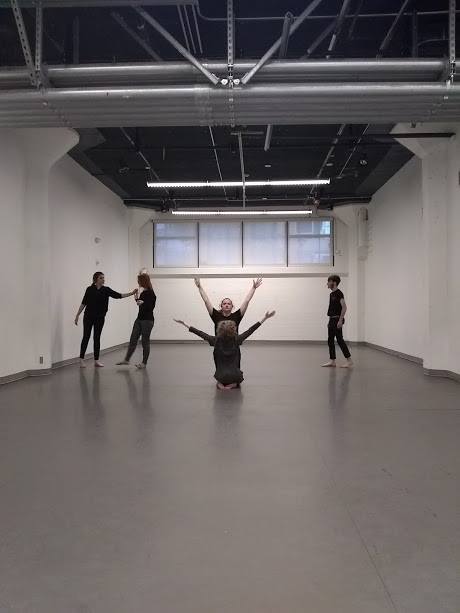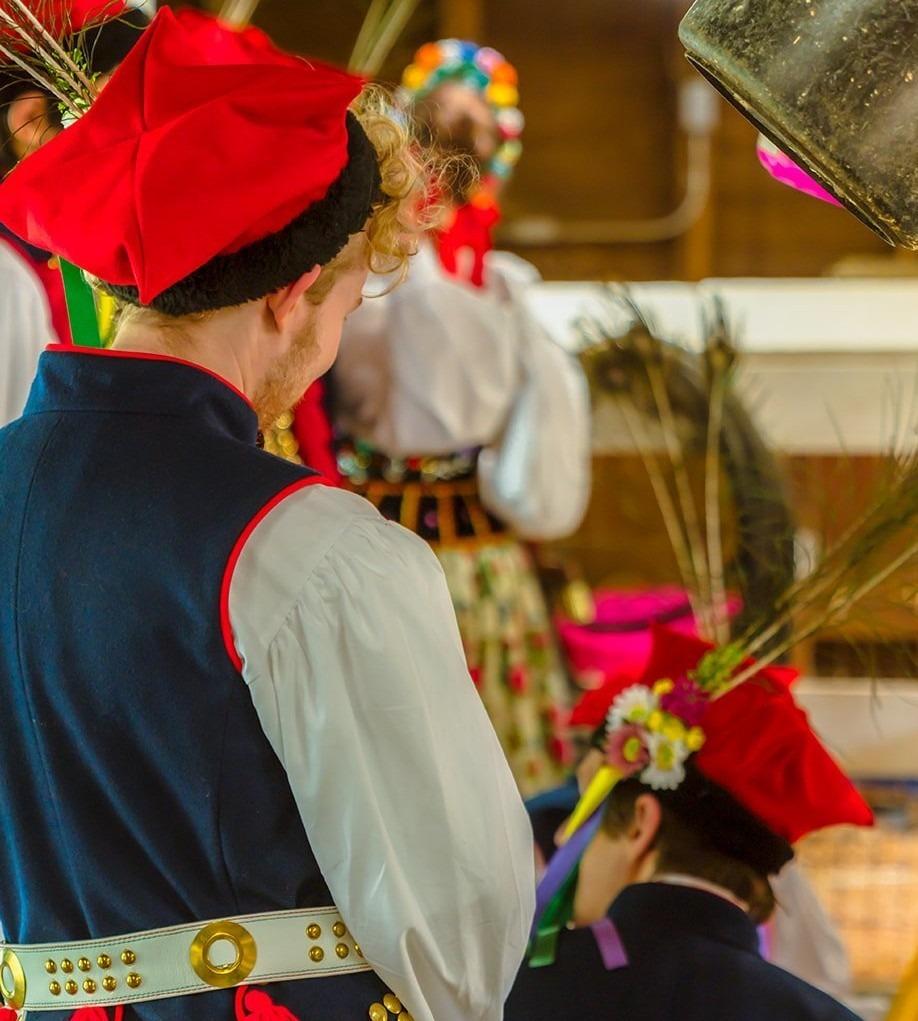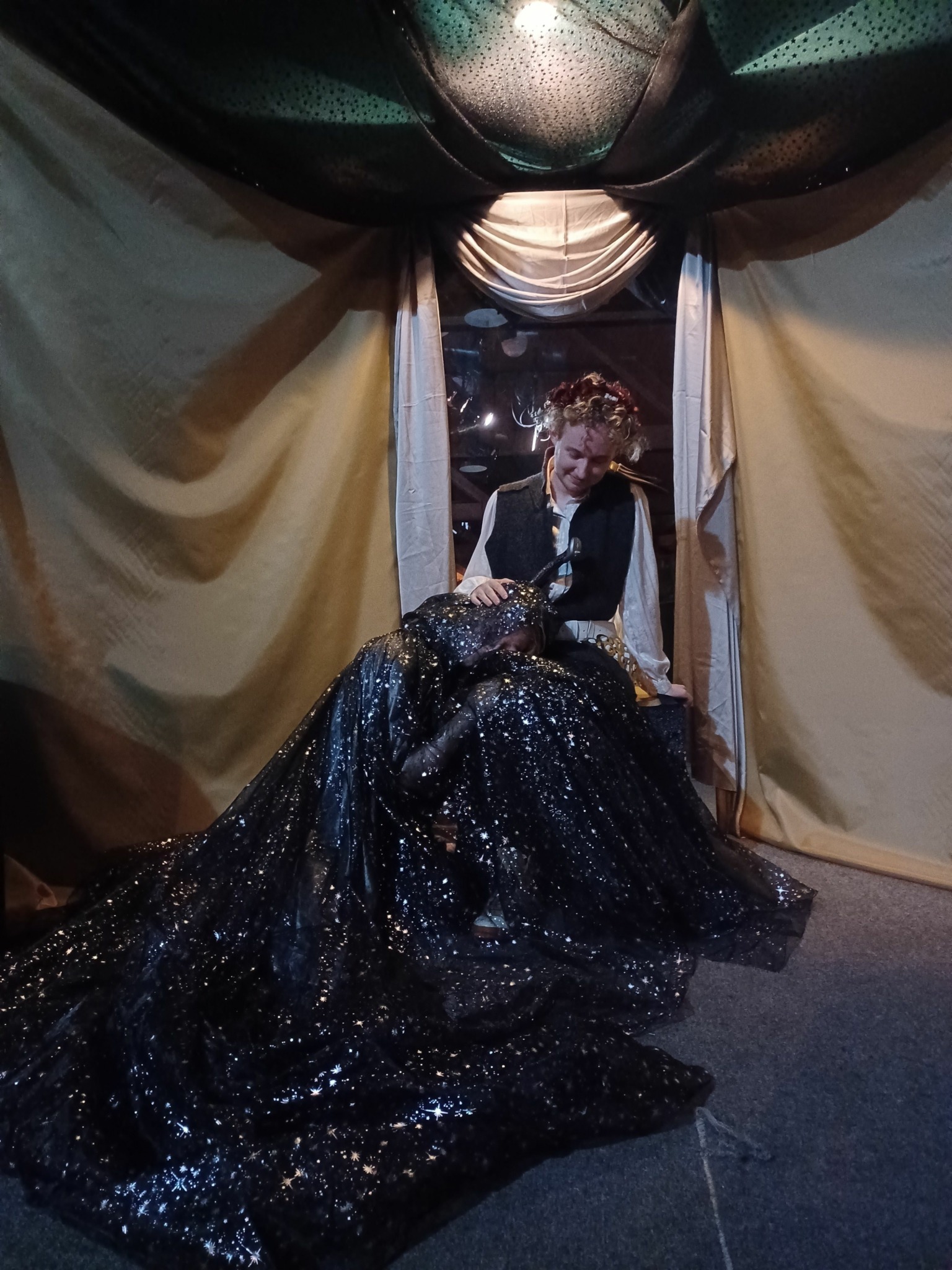We recently connected with James T. Washburn and have shared our conversation below.
James T., appreciate you joining us today. What’s been the most meaningful project you’ve worked on?
My most recent production, FABLE: Tales from Another World, lives at a uniquely meaningful point in time and (metaphorical) space – it marked a turning point for my company’s reach within our community, and drew on aspects of my identity that I hadn’t had an opportunity to express so intimately before.
The production was a one-night-only, immersive world building project. For just six hours, the audience was invited to step into “a world not unlike our own, where magic and mystery await.” Wandering down various paths, they might encounter any number of characters from an expansive canon of original folktales inspired by Slavic, Filipino, and Celtic traditions. Storytellers shared these tales, while the enigmatic Copyist listened to the audience’s own stories; a rotating cast of Suns and Moons danced an endless, looping love story across the mainstage; and Death herself crafted new stories that would only be heard by those lucky enough to draw cards from her divination deck.
The core tenet of FABLE was that it was a world that was Queer at its core. Rather than my usual academic work of teasing out and following threads of Queer subtext in traditional tales, or retelling familiar stories through a Queer lens, I was able to build something beautifully and unapologetically Queer from scratch – every love story was Queer, every performer could present their gender exactly as they wanted to. As we told the cast when we began, “Queerness is in the very fabric of this universe.” This was incredibly freeing – I was able to tell the stories I’d always wished I could hear growing up, and ones that I needed to hear now.
On the other hand, FABLE gave me an opportunity to explore a part of my identity that I was just beginning to connect with. I’d been feeling a pull toward my Polish roots for a long time, and as a lifelong storyteller, FABLE gave me the perfect “way in” to my own culture. I immersed myself in Slavic folktales and traditions and wove these new threads into my work. While I had long been unsure of how being Polish and Queer might fit together, FABLE was an experiment that showed me how these sides of myself could not only be balanced, but deeply intertwined.
Beyond the opportunity to share so many facets of myself, FABLE was also an invaluable opportunity to connect with members of my community in ways I wouldn’t have thought to before. My co-writer, Kyle Morrow, and I have known each other for nearly a decade; but before we began to delve into our cultural backgrounds together, I had never heard them speak about traveling to their family’s village in the Philippines. With every cast member we added, these conversations became both more personal and more expansive; we were able to find unexpected commonalities and connections not just between Polish and Filipino culture, but with the dozens of others. “Bring your whole self” turned out to be an incredibly powerful invitation for performers, who brought with them everything from cultural and spiritual traditions to extremely specific and enthusiastic information on the habits of local birds. In just a few months every detail was woven into the fabric of the world we built together, making the show far richer than it would have been if I’d sat alone in my office writing for years.
Through my work on the fantastical world of FABLE, my understanding of the real world deepened in ways I never expected. I entered one improv rehearsal and came out with extensive knowledge of Soviet era government-funded arts programs; I now know details about about everything from traditional Ojibwe regalia to the Bulgarian language family to how cheerleaders do lifts. All of these things have found their way into my artistic process as I continue my journey – I spend more time listening, now, and I find thematic connections in art I would never have made before.

As always, we appreciate you sharing your insights and we’ve got a few more questions for you, but before we get to all of that can you take a minute to introduce yourself and give our readers some of your back background and context?
I am a gay, trans, and disabled Storyteller-Activist born and raised in Seattle. I pride myself on being a highly collaborative artist; my work is predicated on the idea that a story is best told with many voices. I’m deeply inspired by my Queer, artistic, and Polish communities, and my experiences at the intersection of marginalized identities.
I am a multi-hyphenate artist, with works spanning from the immersive epistolary novella “Sealed with Honey” to “Achilles + Patroclus,” a chamber opera commissioned by the Seattle Opera. I take inspiration from folklore, mythology, and queer history; my work focuses on discovering queerness in traditional stories and reimagining familiar tropes and archetypes through a queer lens.
While I’ve been performing since I was about three years old, I found my voice as an artist with the first musical I directed – a production of Les Miserables independently produced by a cohort of teens who were tired of being excluded from High School shows because of gender, race, or disability. I’ve been championing accessibility in theatre on both sides of the stage ever since, and 2025 will mark my 10th year as a director and producer of Queer, intersectional theatre.
I received my BFA in Original Works from Cornish College of the Arts’ Theatre program, where I met many of my current collaborators and began to develop my theatrical devising process, inspired by Mary Overlie’s Viewpoints. This process has been refined over countless ensemble-generated projects. I’m deeply proud both of the quality and significance of the work it has created, and of the environment I’ve been able to foster through it; no positive review has ever felt as good as hearing an actor say that they felt respected and fully seen for the first time in rehearsals with me.
I’m probably best known in the Seattle theatre community as the Founding Artistic Director of Magpie, an artistic collective focused on innovative cross-disciplinary storytelling. My work at Magpie allows me to collaborate with other artists in new ways, pushing genre boundaries and experimenting with how form and story serve each other. Magpie is especially committed to making the performing arts accessible for both artists and audiences, recording proshots of all our original productions for an international audience and providing paid on-the-job training for artists who haven’t had access to traditional arts educations.
When I’m not playing with actors, you can usually find me in my office taping drafts to the wall conspiracy board-style, or dancing with Syrena Seattle Polish folk dance ensemble on stages around the country.

Let’s talk about resilience next – do you have a story you can share with us?
My journey as an artist has been a series of seemingly insurmountable roadblocks, whether due to discrimination, health, or the pandemic that tested all of our abilities to keep going through uncharted waters. But I think the make-or-break moment that proved I could overcome all these challenges came very early for me, when I was a junior in high school.
I was the first student at my school to come out as trans, a lonely and extremely vulnerable experience. Theatre was my safe space – somewhere I could go to get away from the “real world,” and explore the possibilities of who I could be. I’d been performing for 14 years at this point, training at Seattle Children’s Theatre’s Young Actor Institute and Cornish’s summer intensives, and performing in at least one show every season. I was coming from a place of great privilege as a theatre kid, with access to opportunities that I was certain would lead me to starring roles on Broadway if I worked hard enough. That momentum was brought to a dead stop in the fall of 2014.
The school play that year was A Midsummer Night’s Dream. I was fresh off a summer Shakespeare intensive, a junior, and had played more fairy princesses in my “career” than I could count. There was no question in anyone’s mind that I would be cast as Puck, especially after group auditions came and went. I made only one mistake, which was to request on my audition form that I be cast only as one of the male roles in the show. Our drama teacher, Mr. R, opted not to cast me at all.
I remember so clearly the day the castlist was posted. That stereotypical gathering of anxious teens around the paper, scanning to find their own names. I can still feel my heart drop when one of my friends turned and asked:
“Why’d you decide not to do the show?”
When I asked Mr. R a similar question the next day after class, he gave me a once-over and replied smugly that I “didn’t have that certain something.” (A week later he would practically beg me to join the cast and fill a female role when someone dropped out. I declined). It hadn’t occurred to me until that moment that being trans would be more important to directors than my skills. I had spent so long in a world where what I could do mattered more than anything that I was left reeling at the discovery that who I was could render that completely useless.
I cried for a few days, then spent a few weeks spinning out, left at loose ends without rehearsals to attend. But then I began to talk to some other people, not only from my school but across the district – people who had also noticed trends in casting that shut them out from the roles they objectively fit perfectly. Whether it was because they were trans and supposedly couldn’t fit a masculine archetype, or their skin was too dark to be a screen-accurate Disney princess, or a slight stutter somehow “detracted” from perfect comedic timing, there were dozens of us silently suffering discrimination that, as it built up, could shove us to the sidelines of the art we loved so much for good.
So I rallied. Not because I thought I deserved better – the insecurities we all carry had made me begin to doubt my abilities in the aftermath of my own incident – but because I knew for a fact that all of these other teens deserved better. I let my rage and frustration (and a little bit of spite) fuel me, and drew on years of quietly watching my directors to help me begin to plan my very first production.
While at first I’m sure a seventeen year old presenting a plan for a production of Les Miserables seemed a little far-fetched, the power of my conviction must have shown through; soon a ragtag group of high school techies and I were holding auditions, casting probably one of the most diverse stagings of the show at the time. We were able to secure performance space at a local theatre, rehearsing in backstage areas, outdoors, and at one point even in a yarn dying workshop after hours. And the incredible thing is – it worked. Les Miserables sold out every performance. Every member of the cast gave beautiful, nuanced performances; we pushed and challenged each other to grow as artists over the months we spent together, and each came out far stronger for it.
Although I can’t say that everything that came after that production was easy, I’ve met every challenge since with the knowledge that I can and will beat it. Hearing a “no” isn’t the end, it’s just an invitation to find another path to where you’re going. It’s that same idea that got me through years of college while suffering chronic injuries, and helped me pivot when live performance was cancelled indefinitely. And it continues to serve me every time I encounter new challenges, whether they’re as dramatic as that first time in high school or much more mundane.

For you, what’s the most rewarding aspect of being a creative?
As a director and deviser, the most gratifying moments I experience are when performers express to me how comfortable they feel in the spaces I create.
As theatre artists we’re often told to “leave our baggage at the door,” to make ourselves blank slates and empty vessels in every sense – no tattoos, no physical boundaries, no acknowledgement of challenges we’re experiencing in our lives outside the space; no days off or slowing down when we’re in pain. I spent years following those expectations as well as I could. I pushed through an extreme chronic injury to keep up in class, showed up for rehearsals mid-mental health crisis, and “bravely” pretended I was comfortable with any and all physical contact from castmates. At some point, though, I realized that I could either continue to dedicate myself to my craft in this way and burn myself out, or I could find another way to “show up” for the work.
It’s taken a lot of trial and error, but I’ve slowly built a process that invites artists to bring their whole selves to the work that we do. We check in with each other before we begin for the day. We share physical boundaries before we begin improvisation, and acknowledge that those boundaries may be different today than they were yesterday. We have realistic expectations of each other; no one is asked to put the work above their family or their own well-being. We don’t judge someone if they can only bring 10% some days.
Over and over during my time as a director I’ve had the same conversation with my actors, which makes me feel immensely proud, despite the concerning implications about the industry at large. Actors will take me aside to thank me, to note that I’ve never raised my voice, that they were anxious to even mention chronic conditions or ask not to be touched in certain ways but that they knew they wouldn’t be penalized for it. I’ve created a space where artists can be people; one that they return to again and again, and where we are able to create great work despite (or maybe because of) all the human quirks and faults they bring with them. I’ve created so many pieces of art that I love, but I treasure the trust that my collaborators and I have built above everything.
Contact Info:
- Website: https://www.jamestwashburn.com/
- Instagram: https://www.instagram.com/byjamestwashburn
- Facebook: https://www.facebook.com/jamestwashburnplaywright
- Linkedin: https://www.linkedin.com/in/james-t-washburn-03284a13a/
- Youtube: https://www.youtube.com/@magpieartistsensemble466
- Other: New Play Exchange: https://newplayexchange.org/users/33940/james-t-washburn






Image Credits
Michelle Smith-Lewis, Alexandra Angelova, Jae Kinsman


